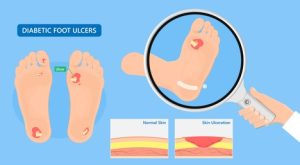Don’t Go Wrong With Foot Ulcers
What is Diabetic Foot Ulcer?

When a person experiences diabetes, they undergo nerve damage and poor blood circulation. This
causes the feet to become vulnerable to skin sores, better known as ulcers.
When the ulcers develop, it needs to get good care as amputation may begin with foot ulcers. A
a non-healing ulcer that causes severe damage to the tissues and bone may require amputation of a toe,
foot, or a part of the leg.
Treating Diabetic Foot Ulcers
There are a few ways to treat diabetic foot ulcers. Namely are:
A. Medications
Prescriptions such as antibiotics, antiplatelets, or anti-clotting medications can be used to treat your
ulcer if the infection progresses even after preventive or anti-pressure treatments. This is because
many of these antibiotics attack Staphylococcus aureus, a bacteria known to cause staph infections, or
ß-hemolytic Streptococcus, which is normally found in your intestines.
Consult with a doctor first regarding medication treatments before making any self-decisions.
B. Surgical Procedure
Ulcers may also be resolved through a surgical procedure. The pressure of the ulcer can be alleviated by
shaving down the bone or removing foot abnormalities such as bunions or hammertoes.
Surgery can prevent your ulcer from becoming worse which can lead to amputation.
How to Prevent Foot Ulcers?
● Inspect your feet daily: Check your feet once a day for blisters, cuts, cracks, sores, redness,
tenderness, or swelling. If you have trouble reaching your feet, use a hand mirror to see the
bottoms of your feet. Place the mirror on the floor if it’s too difficult to hold, or ask someone to
help you.
● Wash your feet daily: Wash your feet in lukewarm (not hot) water once a day. Dry them gently,
especially between the toes. Use a pumice stone to gently rub the skin where calluses easily
form.
Sprinkle talcum powder or cornstarch between your toes to keep the skin dry. Use a
moisturizing cream or lotion on the tops and bottoms of your feet to keep the skin soft.
Preventing cracks in dry skin helps keep bacteria from getting in.
● Don’t remove calluses or other foot lesions yourself: To avoid injury to your skin, don’t use
a nail file, nail clipper, or scissors on calluses, corns, bunions, or warts. Don’t use chemical wart
removers. See your doctor or foot specialist (podiatrist) for the removal of any of these lesions.
● Trim your toenails carefully: Trim your nails straight across. Carefully file sharp ends with an
emery board. Ask for assistance from a caregiver if you are unable to trim your nails yourself.
● Don’t go barefoot: To prevent injury to your feet, don’t go barefoot, even around the house.
● Wear clean, dry socks: Wear socks made of fibers that pull sweat away from your skin, such
as cotton and special acrylic fibers — not nylon. Avoid socks with tight elastic bands that reduce
circulation or socks with seams that could irritate your skin.
